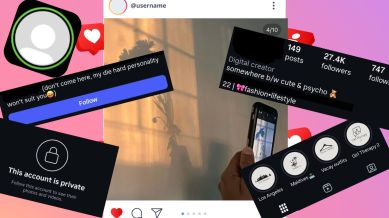Where it’s real, raw and restricted: Inside the secret ‘finsta’ life
A generation of social media users is now moving inward with smaller circles, curated chaos, spam accounts, and ‘Close Friends’ lists.

In a now-deleted Reddit thread, fans gleefully dissected screenshots of Janhvi Kapoor’s spam account on Instagram, once known as @bholisisurat, which she blurted out on an episode of Koffee With Karan. The ‘finsta’, a “fake”, secondary and often private Instagram account, did not have her usual picture-perfect portraits or brand collaborations. This one had blurry photo dumps, pouty mirror selfies, cute pictures with Shiku (her partner, Shikhar Pahariya) and pixelated late-night chaos. And somehow, all that felt more real than something on her verified handle.
Once trophies of public admiration, Instagram accounts are no longer slaves to the aesthetics of perfection. A generation of social media users is now moving inward with smaller circles, curated chaos, spam accounts, and ‘Close Friends’ lists. In a world of algorithms, professional dashboards and analytics, these tiny digital nooks are where real personality thrives.
monthly limit of free stories.
with an Express account.
Sanghamitra Basak (@sanghbee), a digital content creator, says her spam account features a no-filter online personality. “On my main account, I am aware of the audience. Even if I don’t care too much, there’s still a filter. On my spam, it’s just me. No filters, no edits, no captions that sound like I am trying too hard. Just thoughts, moments, and emotions in their rawest form”.
The shift
Though span or finsta accounts have been around for years, the desire for smaller and safer online spaces accelerated during the Covid-19 era, when the world felt like it was on fire. These accounts offered the perfect digital cocoons. Today, Gen Z continues to create digital ‘alter egos’ as a way to reclaim control over how they are perceived and who gets access to their most uninhibited self. Whether you are a celebrity or a college student, the real flex isn’t the number of followers you have but who you let in. These accounts come with velvet ropes, separating the curated and the candid audience. You can’t search these accounts, can’t request to follow, you have to be “invited”. And their owners aren’t shy about this exclusivity. Their Instagram bios would proudly say, “dm for CF” (Close Friends), “spam > main” or “Main me cute, finsta me truth”.
Then, there’s a strategic side to this. Influencers have started to monetise private access through exclusive subscriptions, turning connection into commerce. Instagram rolled out a monthly subscription feature in 2023, allowing fans to become paid members of a creator’s account. It was also the year Instagram launched ‘Broadcast Channels’, with which creators could quite literally slide into your DMs. These channels often feature quick, conversational and casual messages, intended to make the followers feel like they have access to a more “real” side of the creator.
A safe space
Once, Instagram was a gallery, where all the moments were posed, filtered and “collaged”. The carefully curated aesthetics of the 2016 era-VSCO edits and golden hour selfies have been replaced with chaotic seven-slide photo dumps, blurry memes and ‘soft launches’. It’s a shift from performance to presence meant for the few who ‘get it’.
In a way, these private spaces function like modern diaries or digital group therapy. The intimacy of a finsta can foster closer relationships with friends, creating a safe space for sharing emotions. A 2022 study offers some insight into why that is. When interacting in real life, we are usually in social groups that belong to certain contexts — for instance, a workplace would have colleagues, or a home would have family. On social media, there is a ‘context collapse’ or, in simpler words, all these diverse groups become a homogenous audience. Therefore, finstas, with a controlled audience, “provide an avenue for the sharing of images and feelings that do not conform to stereotypical expectations” as well as places for “cathartic venting”.
Dishita, a 20-year-old student at Delhi University, says, “I wanted a separate account where I would only have my close friends and I can post anything without giving it a thought.”
“I usually post fun and irrelevant reels that I make with my friends or even family. Sometimes when I just want to humour myself, I post crack memes. Basically, it’s the other side of me, even though I am not a person who gets very conscious while posting on my main account, it feels super cool to be able to articulate and express my thoughts where there are no boring people in my account,” she added.
“I am a very opinionated person but my finsta is a space where I can post anything without the fear of getting judged”, says Dishita.
A finsta often feels low-stakes, where users don’t have to keep up appearances. For Basak, it offers a “space to exist without pressure”. “My main feels like a magazine, and this one feels like a diary. It’s where I can be messy, random, and real without wondering who’s judging,” she says.